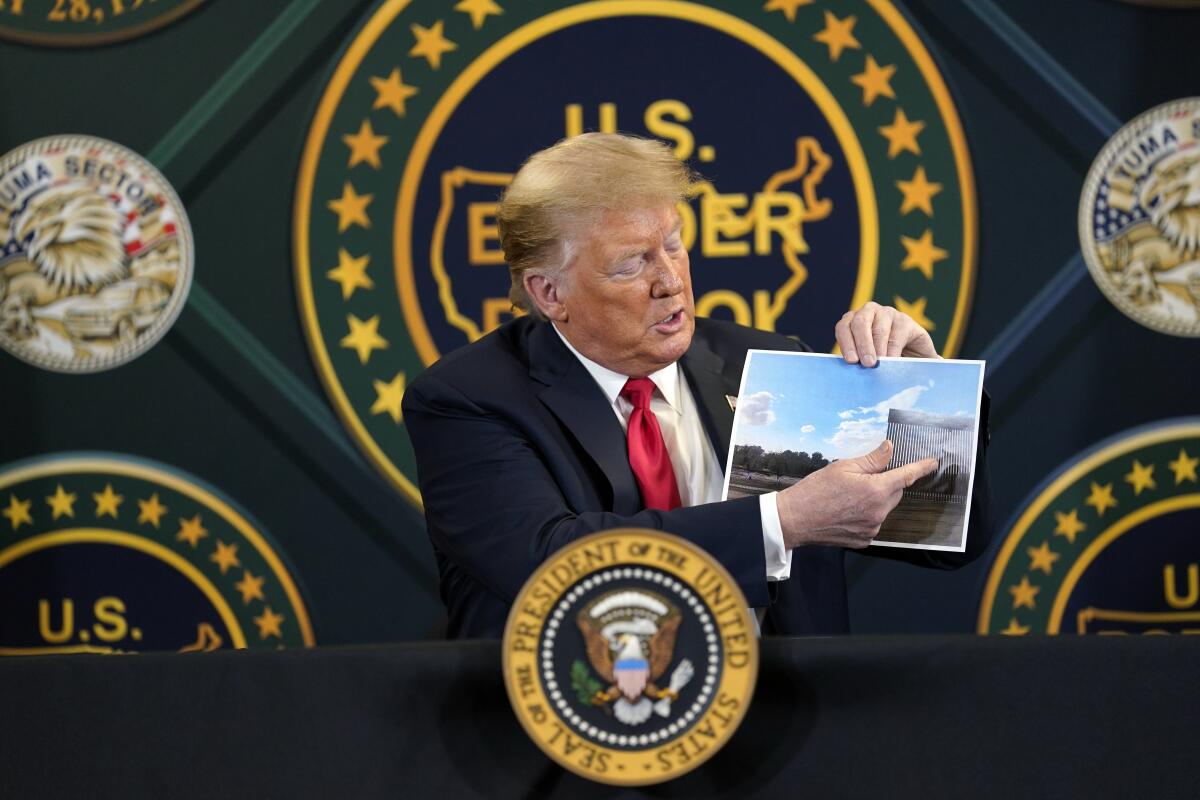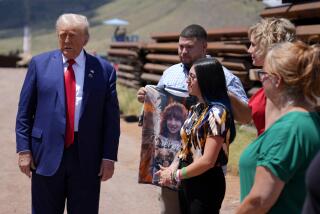Trump campaigns on border wall progress. There’s not much of it

- Share via
WASHINGTON — President Trump, whose plans to campaign on a booming economy were ruined by the coronavirus, traveled Tuesday to the southern edge of Arizona to highlight completion of “more than 200 miles of powerful border wall” with Mexico.
He didn’t mention the fine print.
Nearly all 216 miles built since Trump took office replaced outdated or dilapidated fencing. Only about “three miles of new border wall system [have been] constructed in locations where no barriers previously existed,” according to Homeland Security’s June 19 status report on the wall.
Trump repeatedly pledged during and after his 2016 campaign that he’d make Mexico pay for “a big beautiful wall” on the entire 1,954-mile border. So far, the Trump administration has spent $15 billion on the project. Mexico has not contributed anything.
Aware of the discrepancy, Mark A. Morgan, the acting commissioner of U.S. Customs and Border Protection, said hairsplitting over how much of the wall is new amounted to “a false political narrative.”
“From an operational law enforcement perspective, those are new miles of wall system that are going into the ground,” Morgan told reporters.
Trump promised to complete “close to 500 miles” of wall by the end of 2020 during a roundtable discussion at a U.S. Border Patrol station in Yuma, Ariz., before touring a nearby section of wall.
He touted the new and refurbished walls as “pretty much un-climbable” and said illegal border crossings have dropped 84% over the last year, although the drop is partly due to the economy cratering this year during the COVID-19 outbreak and aggressive efforts to expel migrants, including asylum seekers and unaccompanied minors.
The heavy salesmanship by the president, making his second trip to Arizona in six weeks, suggested he is still searching for a winning campaign message less than five months before election day, especially in a state that he won handily in 2016 but that now appears in play for Democrats.
Former Vice President Joe Biden, the presumptive Democratic nominee, leads Trump by four percentage points in Arizona, according to the Real Clear Politics average of recent polls.
The visit to Yuma, and later to Phoenix, marked Trump’s first public appearance since his poorly attended rally Saturday night in Tulsa, Okla., which has sparked speculation by some Republicans that Trump’s campaign needed major retooling.
The campaign had predicted a massive overflow crowd for his first public rally in more than three months, but the indoor arena in Tulsa was two-thirds empty, and Trump was humiliated, according to aides.
He also was angry that his aides had confirmed to the press before the event that six Trump campaign staffers involved in organizing the rally tested positive for COVID-19. (The total is now eight.)
For an hour and 40 minutes, Trump delivered a rambling and at times overtly racist speech that eclipsed his prepared remarks, which began with an overview of select accomplishments — confirming conservative federal judges, increasing the Pentagon budget and improving the Department of Veterans Affairs.
Trump’s scripted attempts to paint a negative portrait of Biden were lost in a torrent of grievances and invective toward the media, China and the coronavirus, not to mention a bizarre reenactment of his tentative walk down a ramp after a commencement address days earlier.
“The most important thing in a campaign is the message. And the most powerful message he needs to develop is what’s wrong with Joe Biden,” said Ari Fleischer, who was White House press secretary under President George W. Bush. “If this election is about the incumbent, chances are Donald Trump will lose.”
Jen Psaki, a veteran of President Obama’s 2008 and 2012 campaigns, said the Tulsa event showed that Trump or his campaign haven’t settled on “his best argument about why he’s running.”
“There are many advantages of running for reelection as an incumbent president,” she said. “But the challenge is that you are judged not by your aspirations but [by] what you’ve actually accomplished and where the country actually sits.”
Trump’s visit to Arizona and his continuing focus on the border wall largely ignored the health crisis that has overshadowed the 2020 race, even as the state is ravaged by a spike in coronavirus infections. The number of confirmed cases, now around 55,000, has doubled over the last two weeks.
On Tuesday, Arizona tallied the most COVID-19 cases of any day yet — 3,591 — and its hospitalization rate set a record for an eighth straight day, casting a heavy shadow on the president’s visit, especially his second event, a speech sponsored by a conservative advocacy group at a Phoenix church.
Trump has sidelined the White House coronavirus task force in recent weeks and spoken of the pandemic as if it had ended, even claiming in Tulsa that he has asked aides to “slow down” testing to keep the overall number of reported cases from rising. The U.S. death toll from COVID-19 tops 121,000.
Before leaving the White House on Tuesday, Trump scoffed at his press secretary’s claim that the president’s call to slow testing was meant as a joke.
“I don’t kid,” Trump told reporters on the South Lawn. “By having more tests, we find more cases.”
In recent weeks, doctors have tracked sharply rising infections in Florida, Texas, South Carolina and Oklahoma, all states that Trump won in 2016 and that aggressively lifted lockdown restrictions. Cases also have risen in California, which reported more than 5,000 new infections Monday, topping its previous record of 4,515 the day before.
Trump is aware, aides say, that he may not convince even his supporters to risk their health to attend crowded rallies or return immediately to pre-pandemic routines to help the economy rebound. But some analysts say he has little choice.
“It’s valid for him to keep talking about the strong economy before the pandemic hit,” Fleischer said. “Most voters give him a mulligan on the pandemic, and memories of the strong economy remain fresh. But he better be doing everything he can to manage this crisis well so that in the fall people give him credit for being competent.”
Democrats are less charitable, insisting that Trump’s hyperbole and “I alone” approach are ill-suited for the moment.
“The country needs a ‘We, the people’ president,” said Democratic pollster Peter D. Hart. “The one thing we know is [Trump] has no empathy, and that’s a fatal flaw this year, to have no ability to look at the world through other people’s eyes.”
Trump’s boasts about his border wall are not without merit, even if much of the wall isn’t technically new, according to Mark Krikorian, executive director of the Center for Immigration Studies in Washington and an advocate for stricter enforcement of immigration laws.
“Replacing crappy, rusting 1970s barriers that are 8 feet high with 30-foot bollard wall — that’s ‘new wall,’” he said. “The president has a case to make that he’s actually achieved results.”
But making the wall a symbol of Trump’s harsh approach to immigration enforcement has drawn scrutiny on the project itself, especially since construction has occurred only on 10% of the border.
Trump tweeted a complaint Monday night after watching a Fox News report on the slow progress, declaring that the wall is “well under construction, fully financed and already over 200 miles long.”
It may not matter. Polling suggests that immigration, which helped propel his unexpected election four years ago, is not the top concern for even Trump’s voters now.
“The whole wall debate is less salient now because there’s almost no one sneaking across the border anyway, which is partly because of the COVID outbreak,” Krikorian said. “And partly because the changes are working.”
Times staff writer Molly O’Toole contributed to this report.
More to Read
Get the L.A. Times Politics newsletter
Deeply reported insights into legislation, politics and policy from Sacramento, Washington and beyond. In your inbox twice per week.
You may occasionally receive promotional content from the Los Angeles Times.










